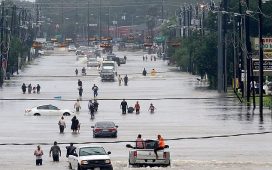Experts have warned that Avian flu, which has been wreaking havoc across the UK’s bird farms, has spread from birds to mammals for the first time. This means there is a slight chance the virus could jump to humans. The disease, which has killed over 200 million birds, has been shown to infect over 200 mammals, including foxes and otters. Public health officials have said that although the risk is very low, it is possible that the mutation in mammals could begin infecting humans.
Further targeted surveillance and testing of animals and humans exposed to the virus in Britain is set to be carried out. The Animal and Plant Health Agency (APHA) has tested up to 66 mammals so far and found nine otters and foxes were positive for highly pathogenic avian influenza (HPAI) H5N1. It also tested seals for the virus.
It is thought the animals testing positive were fed with dead or sick wild birds infected with Avian flu. While it was found that the animals had a mutation of the virus, making it more likely to infect mammals, there was no evidence of the virus jumping between mammals.
The APHA said there was “a very low likelihood of any widespread infection in GB mammals”.
Prof Ian Brown, APHA’s director of scientific services, told BBC News: “A sick or a dead wild bird contains an awful lot of virus. So scavenging mammals that will be opportunistic and predate on dead or sick birds will be exposed to very large quantities of virus. That gives a possibility for the virus to enter a host population that it doesn’t normally maintain in.”
Animals that ingest wild-bird droppings, or that prey on infected animals, can also develop the disease. But last month, experts warned over the H5N1 strain of avian influenza after an outbreak in Spain suggested that the flu can spread from one infected mammal to another.
First reported in Eurosurveillance on January 19, an outbreak occurred on a mink farm in Carral in October 2022. Genetic sequencing revealed the animals were infected with a new variant of H5N1, which has genetic material from a strain found in gulls.
It also has a genetic change that is though to be increase the likelihood to boost the ability of some animal-flu viruses to reproduce in mammals. Wendy Puryear, a virologist at Tufts University in Medford, Massachusetts, told Nature that the strain puts bird flu in “uncharted territory”.
Hualan Chen, a virologist at the Harbin Veterinary Research Institute in China, warned that the spread of the H5N1 strain between mammals “may pose a higher risk to public health”.The H5N1 strain has been responsible for one human death in the UK since its latest outbreak which began in October 2021. There have been four other human deaths, including one in China.
READ MORE: Pandemic fears in wake of ‘concerning’ bird flu outbreak at mink farm
The World Health Organization (WHO) notes that there have been almost 870 cases of human infection with the avian influenza H5N1 virus reported from 21 countries over the last 20 years. Up to 457 of these cases were fatal. This suggests a relatively high case fatality rate in people who become infected.
Now, the UK’s national avian flu taskforce is bolstering its surveillance of cases in mammals and genome analysis of the virus while keeping close tabs on the spread in global populations of wild birds.
Prof Brown said: “The virus is absolutely on the march. And it’s almost remarkable – it’s a single strain.”
He warned that he is “acutely aware of the risks” of the disease turning into a pandemic like COVID-19.
Prof Brown said: “This global spread is a concern. We do need globally to look at new strategies, those international partnerships, to get on top of this disease. If we don’t solve the problem across the globe, we’re going to continue to have that risk.”
DON’T MISS
UK poised to rejoin £80bn EU scheme as Sunak scrambles to strike deal [INSIGHT]
Europe ‘on track’ to end reliance on China for electric cars by 2030 [REPORT]
Energy supply will be ‘tighter’ tonight but Brits can be paid to help [REVEAL]
Thijs Kuiken, a professor in the department of viroscience at Erasmus University Medical Centre in Rotterdam, has previously warned that the chance of a human spillover is small. However, he said that “the impact – if it does happen – is very big, because it means that we then have a new influenza pandemic”.
Dr Meera Chand, incident director for avian influenza at UKHSA, said: “Latest evidence suggests that the avian influenza viruses currently circulating in birds do not spread easily to people. We remain vigilant for any evidence of changing risk.
“There have recently been some detections of avian influenza viruses in a small number of mammals in the UK. However, the risk assessment conducted by UKHSA and partners did not identify any signals of increased risk to the general public from avian influenza at present.”
This comes as the UK continues to suffer the worst Bird flu outbreak in history, which last year forced more than a third of poultry farms to roll out control measures to limit the spread of the disease. This was regardless of whether they had been being directly affected by the disease or not.
In previous years, the HPAI virus mostly died out during the summer and early autumn months, but it remained prominent all year round in 2022. The 1918 flu, thought to have killed as many as 50 million people, is an example of a pandemic that has been linked to an avian influenza and originating in birds.









